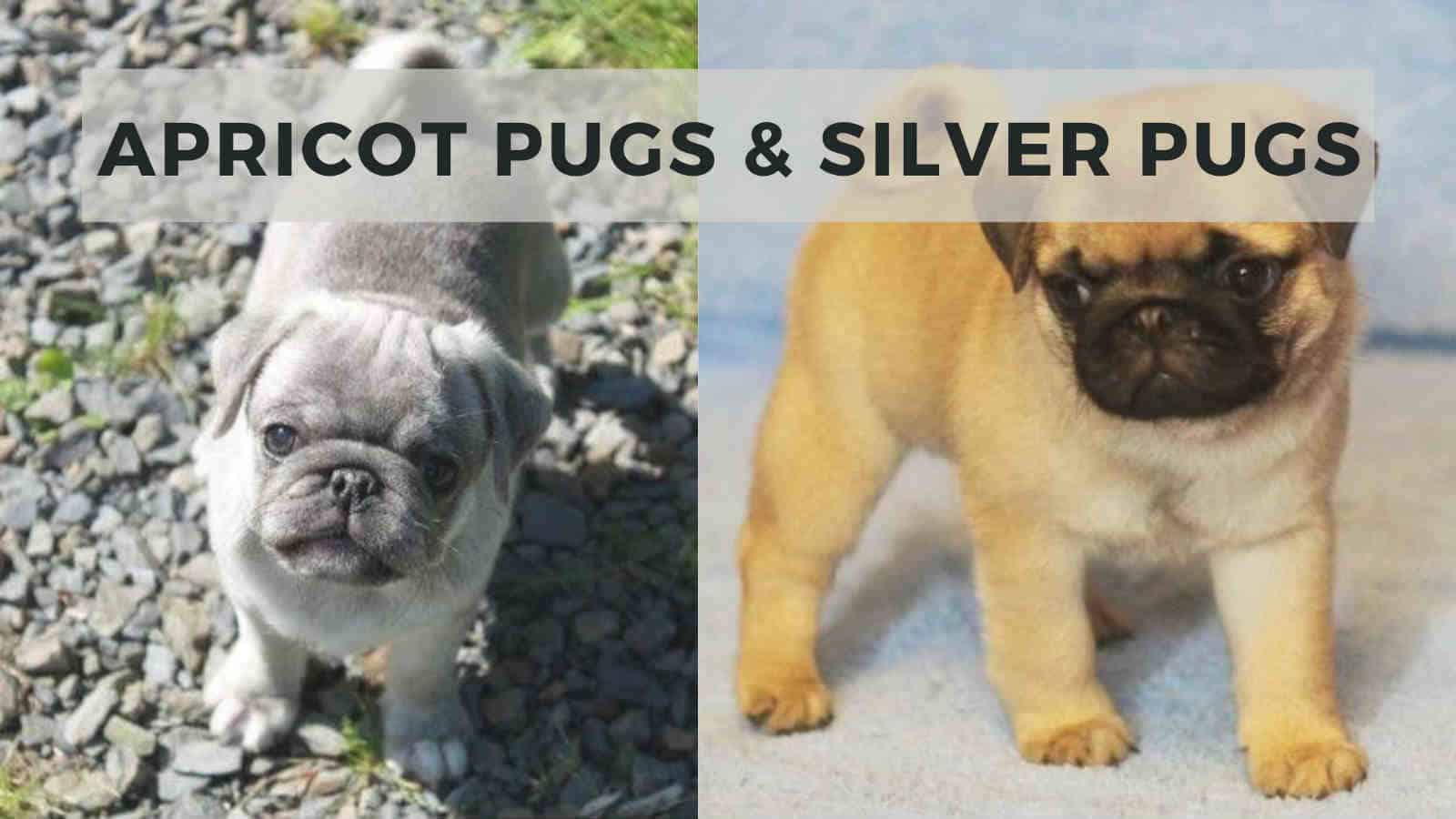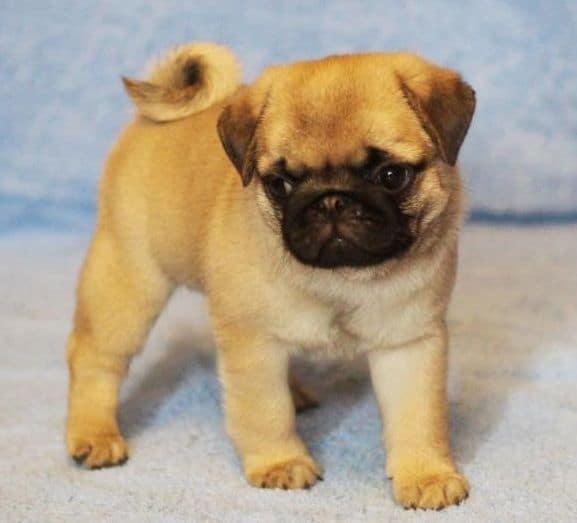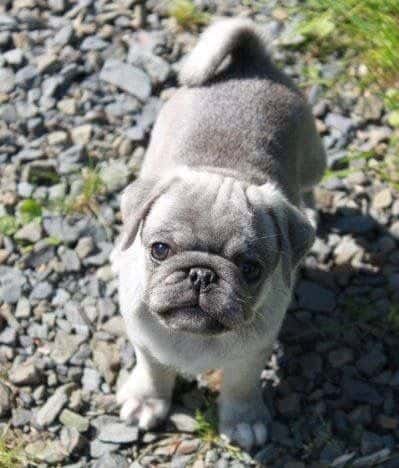Listed number 28th of 196 breeds recognized by the American Kennel Club (AKC), the Pug is one of America’s favorite breeds. Known for their delightful antics and described as charming, mischievous, and loving, they are a wonderful family dog.
Despite the classic fawn and black mask? Do you know that Pugs also come in apricot and silver?
Here is everything you need to know about the apricot Pugs and silver Pugs.
The Origin of Apricot and Silver Pugs
Pugs are part of the toy group in the AKC. Most of the breeds in the toy group were bred specifically to be companions to people.
Their smaller size means they are portable, making it easy to travel with their owners. The toy group is known for being sociable and affectionate, and the Pug is no exception!
One of the world’s most ancient breeds, Pugs were originally the companions of Chinese emperors. More recently, they were the mascot for Holland’s Royal House of Orange. Historic lore says a Pug saved the life of William, the Prince of Orange, by raising an alert about an imminent attack in the night.
Today, Pugs are frequently found as family pets. These clever little dogs can also excel at sports like obedience and agility. Pugs are described as “living to love and be loved”. They are very devoted and affectionate companions.
Although small, Pugs are mighty. Their Latin motto is “multum in parvo” or “a lot in a little”. They adjust well to country or city life, including being great apartment dogs. They get along with other dogs but can also thrive as an only dog.
They’re great with kids and the elderly. They typically do very well with other pets in the household. Their coat is low-maintenance, and their shedding is manageable. They can be a perfect match for a first-time dog owner.
What Colors Do Pugs Come In?
The AKC and CKC (Canadian Kennel Club) recognizes two colors in a Pug, fawn and black.
These are the only colors that are allowed to compete in the dog show ring. Both colors have a black mask, but on the black Pug, the mask is invisible amongst their totally black fur.
The fawn (tan) color has a range of shades, including apricot and silver.
Other kennel clubs worldwide have separated some of the colors within the fawn range into their own color categories. The Kennel Club in Britain allows silver, apricot, fawn, and black as four distinct colors.
So What is An Apricot Pug or Silver Pug?
1. Apricot Pug
image source: Pinterest
As a baby, apricot Pug puppies may be difficult to differentiate from fawn puppies. Pug puppies are darker at birth and lighten as they grow.
Apricot Pugs can either be a deep shade of apricot, a rich orangey color, or a lighter shade that is more similar to fawn.
Conversely, some apricot Pugs get darker as they age, finishing up with deeper gold color.
2. Silver Pug
image source: Pinterest
A silver pug puppy may also be difficult to spot amongst their fawn siblings. They will appear very similar as young puppies.
As they age, the silver color will become more apparent. The silver color is described as being a cold, silver cast. Where an apricot or fawn Pug will reflect the color of the sun, a silver Pug will be the color of the full moon.
3. Apricot Pug and Silver Pug Markings
All fawn, apricot, and silver Pugs might have the same black mask and markings. The markings are to be as clear and defined as possible.
They should have black on the muzzle, ears, spots on the cheeks, a diamond (called a thumb mark) on the forehead, and a line from the occiput (top of the skull) to the tail, called the back trace.
Silver Pugs & Apricot Pugs: Is There any Difference?
The only difference between a silver Pug and an apricot Pug is their color. In America or Canada, they would both be registered as fawn, even though they look distinctly different.
Both are purebred Pugs. There are no differences in size, health, or temperament associated with either color.
Characteristics of Silver & Apricot Pugs
- Size: 12-14″ for male Pugs and 10-12″ for female Pugs
- Coat: Double layered coat
- Exercise: 40 minutes a day, 20 minutes per session
- Weight: 13 to 30 lbs for male Pugs and 13 to 18 lbs for female Pugs
- Lifespan: 12 to 15 years
- Temperament: Playful and gentle; non-violent and obedient
- Good With Children: Incredibly great while interacting with children
- Good With Pets: Need a little socialization training, peaceful with other pets nonetheless
- Breed: Toy breed
Note:
Pugs love their food and can easily become overweight. Carrying extra weight isn’t healthy for them, so be sure to watch their portions and waistline.
Silver and Apricot Pugs: Behavior and Personality
Their Temperament
Pugs have always been bred to be companion animals.
- They love people and are great with children.
- They make excellent family pets.
- They get along well with other animals and other dogs.
Pugs are friendly and outgoing. They make excellent therapy dogs. They are gregarious and love meeting new people.
Silver and Apricot Pugs: Health and Nutrition
Overall, Pugs are a reasonably healthy breed, but the breed does have some health concerns. All four colors of Pug share the same breed predispositions.
1. Their Nutrition
Pugs have no dietary requirements unique to their breed. A high-quality, balanced and complete commercial diet will be appropriate for them.
Many Pugs do well on fresh or home-made diets. If you are making your Pug’s food, ensure you have a recipe that will provide them with everything they need.
2. Their Health Risks
Problems in Eyes
- Ulcers
The beautiful, appealing eyes of a Pug are also one of their most vulnerable areas. Pug’s eyes protrude, making them susceptible to corneal ulcers (scratches on the eye’s outer layer). These can be extremely painful and very serious. If you believe your Pug has a scratch on their eye, they should be seen by a veterinarian immediately.
- Dry Eye/KCS
Pugs are also at a higher risk for Kerraconjunctivitis Sicca (KCS), also known as “dry eye”. KCS is an inflamed, dry eye as a result of a lack of water in normal tears.
Tears are vitally important in eye health. Without proper tears, eyes become irritated, and the outer layer of the eye (cornea) turns brown to protect the eye. Left untreated, dogs with KCS will go blind.
If you notice any discharge from your Pug’s eyes, you should get them to your veterinarian ASAP.
3. Breathing Issues
The adorably squishy Pug face can pose challenges with breathing. If your Pug seems to struggle to breathe or snores excessively, have them examined by your veterinarian. Some brachycephalic (short-faced) dogs need surgery to allow them to breathe more easily.
4. Joints
Pugs are prone to hip dysplasia and luxating patellas. Hip dysplasia is a developmental abnormality in the hips. The ball of the hip doesn’t fit snugly into the socket of the joint.
Hip dysplasia can be diagnosed in young dogs through x-rays. Many dogs may not show symptoms until they are older and have developed painful arthritis in their unstable joints.
Luxating patellas refer to the kneecap being able to luxate or pop out of place. A common symptom is a dog who will occasionally hop on one leg as they run. When the kneecap pops back in place, they resume running normally.
A veterinarian can examine the knees and determine whether they will luxate. Pugs with luxating patellas often require surgery to correct the problem.
5. Pug Dog Encephalitis
Pugs are at risk for a disease unique to their breed, Pug Dog Encephalitis (PDE), also called Necrotizing meningoencephalitis (NME). PDE/NME is an inflammatory disease of the central nervous system.
PDE/NME is a progressive and eventually fatal disease. Fawn, female Pugs are at a higher risk than other colors. Because apricot and silver are variants of fawn, they would also be at a higher risk than black Pugs.
There is a genetic test available to determine whether a Pug carries the gene that would put them, and any future puppies, at a higher risk of developing PDE/NME.
6. Pyruvate Kinase Deficiency
Pyruvate Kinase Deficiency is a deficiency of the pyruvate kinase enzyme. This deficiency results in easily damaged red blood cells.
Pugs are at a higher risk for this disease. Although this disease can be managed, it is usually fatal over time. There is a genetic test to determine whether a Pug is at risk.
7. Health Testing
Any potential Pug parent should undergo health testing before breeding is planned. Ensuring all the health testing recommended by the Pug Dog Club of America is done gives future puppies the best chance of a long, healthy, happy life.
Silver and Apricot Pugs: Exercise & Training
1. Training your Pug
Silver and apricot Pugs are incredibly intelligent and obedient. However, they do have a minor streak of stubbornness which can be tackled by training them properly.
Since they are gentle and soft-hearted, they do not respond well to strictness and harsh punishments and can often turn against you and rebel.
Hence, positive reinforcement and appreciation are necessary to train your Pug.
Overall, Pugs are friendly with everyone and have good socializing skills.
Even then, you need to train your Pug to be more sociable and behave well in specific environments.
If your Pug’s stubbornness gets the best of you, a professional trainer will be an excellent option for you!
2. Exercising your Pug
Apricot and silver Pugs have the same energy level as fawn and black Pugs. Pugs love to snuggle with you on the sofa. They are not a high energy breed, but they are playful and lively and would love to join you on an adventure.
Brachycephalic, or squishy-faced, dogs like the Pug are less tolerant of hot weather. On hot summer days, ensure they have lots of breaks, plenty of fresh water, and avoid strenuous exercise.
The best time to walk your silver or apricot pug is early morning or later evening, missing the heat of the day. Pugs benefit from regular exercise and would enjoy at least 30 minutes of walking every day.
Walks are essential for environmental enrichment as well as exercise. Regular walks will help keep your Pug fit and lean. Walks are an excellent chance for your Pug to sniff and explore, enriching their life.
Silver and Apricot Pugs: Grooming
Pugs are a low-maintenance breed for grooming. You can do everything your Pug needs in your own home.
Regardless of your Pug’s color, their coat will be the same. The Pug coat is short, fine, smooth, soft, and glossy. Pugs shed a lot; you will certainly find hair around your house and on your clothes.
By following the list we have created, you can help keep your Pug healthy and happy.
- Daily brushing will help remove loose hair, manage shedding, and keep your Pug’s coat healthy.
- Bathing your Pug no more than once a month will keep their coat in good condition. Pugs do not need frequent bathing. If they are mucky after a walk or have found something gross to roll in, you can bathe them in your sink or tub. Their short coat will dry quickly.
- Trimming nails weekly helps keep their feet and joints healthy. Long nails make it difficult to walk and can cause pain. With some practice, your Pug can tolerate nail trimming calmly.
- Cleaning wrinkles and nostrils as needed to keep your Pug healthy. Depending on how deep your Pug’s face wrinkles are, you may need to clean inside them to keep the skin healthy and dry. Wipe between wrinkles and nostrils to prevent build-up.
Finding Your Apricot and Silver Pugs
It is always wonderful to rescue an animal in need. Look at shelters and rescues in your area and see if there is a Pug who would be a good fit for your life.
We’ve prepared a detailed blog about dog breeders along with great tips on how to find a reputable and responsible breeder. This article can be a great place to start the search for your perfect Pug.
Silver vs Apricot Pug: Which One is Right For You?
All Pug colors are equal when it comes to health and temperament. Either Apricot Pugs or silver pugs are delightful dogs who can be a wonderful fit for even a first-time owner.



